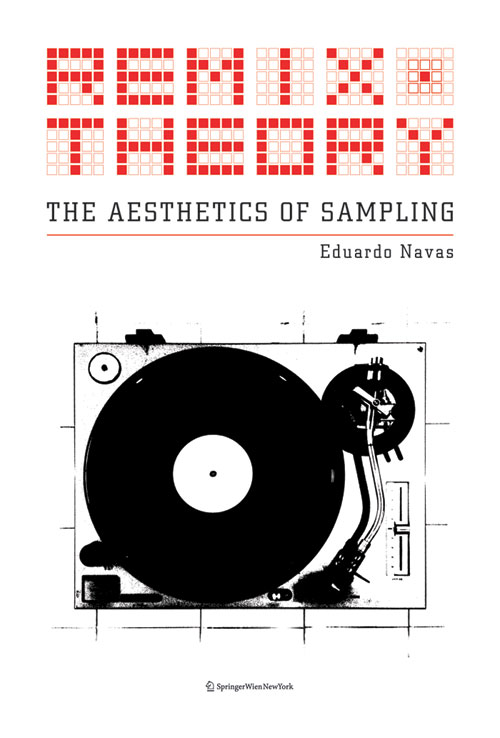Eduardo Navas: Remix Theory: The Aesthetics of Sampling (2012)
Filed under book | Tags: · 1970s, 1980s, mashup, music, music history, music theory, remix, sampling

“Remix Theory: The Aesthetics of Sampling is an analysis of Remix in art, music, and new media. Navas argues that Remix, as a form of discourse, affects culture in ways that go beyond the basic recombination of material. His investigation locates the roots of Remix in early forms of mechanical reproduction, in seven stages, beginning in the nineteenth century with the development of the photo camera and the phonograph, leading to contemporary remix culture. This book places particular emphasis on the rise of Remix in music during the 1970s and ‘80s in relation to art and media at the beginning of the twenty-first Century. Navas argues that Remix is a type of binder, a cultural glue—a virus—that informs and supports contemporary culture.”
Publisher Springer, Vienna, 2012
ISBN 3709112621, 9783709112625
230 pages
RemixTheory.net (from the author)
Publisher
Peter Hoffmann: Music Out of Nothing? A Rigorous Approach to Algorithmic Composition by Iannis Xenakis (2009)
Filed under thesis | Tags: · algorithm, composing, composition, computer music, computing, electroacoustic music, listening, music, music theory, sound
“GENDY3 (1991) by Iannis Xenakis (1922-2001) is a piece of computer generated music. But it is more than just ‘computer music’. GENDY3 is the culmination of Xenakis’ lifelong quest for an ‘Automated Art’: a music entirely generated by a computer algorithm.
Being a radical instance of a pure algorithmic composition, GENDY3 is, in a precise mathematical sense, a computable music: every aspect of its sonic shape is defined by an algorithmic procedure called ‘Dynamic Stochastic Synthesis’ (‘Génération Dynamique Stochastique’, or GENDYN for short).
The GENDYN Project, started by the author in 1995/96 with a research at CEMAMu, then the composer’s research center near Paris, exploits this computability for developing and documenting the GENDYN concept, in order to understand its various ramifications and to make it accessible for further research and production. To this end, the author implemented Dynamic Stochastic Synthesis in a new program called the ‘New GENDYN Program’ which, in addition to ‘recomposing’ GENDY3 in real time, makes it possible to inspect and control the algorithmic composition process, thereby opening up new perspectives both in Computational Musicology and in computer music creation.
For music analysis purposes, GENDY3 has been completely resynthesized. The simulation of the genesis of GENDY3 ‘in vitro’ made possible by the New GENDYN Program permits the systematic exploration of the ‘decision space’ of the composition model, contributing to a deeper understanding of both its potentials and limitations, and the complex interaction between ‘material requirements’ and compositional freedom within which the composer navigated.
The study of the GENDYN compositions provokes many fundamental questions about computing, listening and understanding, of creation, interaction and computer music aesthetics. It is shown that Xenakis, unlike many computer music composers, had no ambition whatsoever to emulate traditional musical thinking with the computer. Instead he realized his sonic vision in an abstract physical model of sound pressure dynamics yielding higher-order musical structures as emergent epiphenomena. This unusual approach addresses the medium of electroacoustic algorithmic music, i.e. the physics of sound, as well as the computability of sound as subjects of artistic creation. This approach seems to the author to be of a higher value for the foundation of a ‘true’ computer art than the widespread ambition to emulate human creativity by computers and to build up an artificial brave new world of music.” (Abstract)
PhD thesis
Fakultät I – Geisteswissenschaften, Technische Universität Berlin
Vorsitzender: Stefan Weinzierl
Berichter: Christian Martin Schmidt
Berichter: Helga de la Motte-Haber
346 pages
PDF (updated on 2017-8-4)
Comment (1)Larry Polansky: The Early Works of James Tenney (1983)
Filed under book | Tags: · 1960s, composing, computer music, music, music history, music theory

“James Tenney was a composer and influential music theorist. He studied piano with Eduard Steuermann and composition with Chou Wen-chung, Lionel Nowak, Paul Boepple, Henry Brant, Carl Ruggles, Kenneth Gaburo, Lejaren Hiller, John Cage, Harry Partch, and Edgard Varèse. He also studied information theory under Lejaren Hiller, and composed stochastic early computer music before turning almost completely to writing for instruments with the occasional tape delay, often using just intonation and alternative tunings. Tenney’s notable students include John Luther Adams, John Bischoff, Peter Garland, Larry Polansky, Charlemagne Palestine, and Marc Sabat. He performed with John Cage, as well as with the ensembles of Harry Partch, Steve Reich, and Philip Glass.” (source)
Published in Soundings #13, edited by Peter Garland
181 pages
via Larry Polansky
Comment (0)
